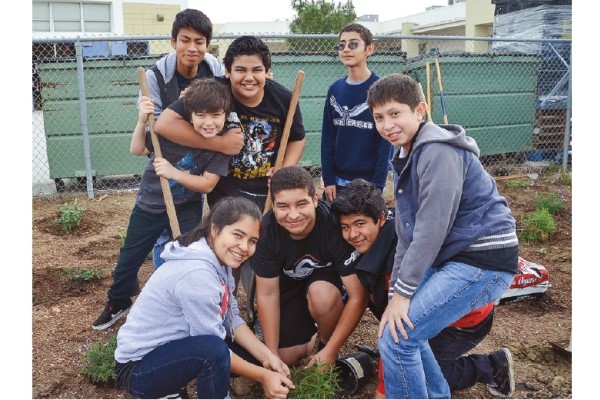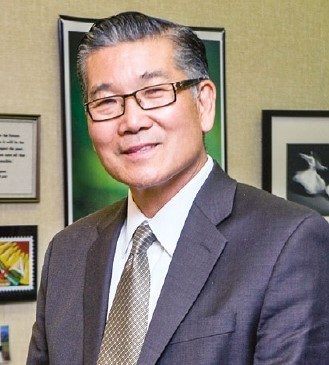Educating English Learners for Democracy
February 01, 2017

With more than 50 languages spoken among students and their families, the Anaheim Union High School District often has been called a mini-United Nations. Our schools act as an established gateway for refugee and immigrant communities from Mexico, Central America, Africa, the Middle East, South Asia and Southeast Asia.
This population of students joins a large number of mostly U.S.-born, long-term English learners who have grown up in low-literate, Spanish-speaking households. Many of the students persistently underperform academically and comprise the largest at-risk student demographic. These long-term English learners generally do not speak English with an accent so their underperformance often feeds into negative stereotyping as “Hispanic kids are lazy” or that their culture does not value education as, say, the Asian immigrants do.
This is a huge misunderstanding as their needs are really more about literacy and language development than being somehow culturally deficient. The research shows, for example, that a Korean kid whose parents work in a restaurant but who have some college education in Korea will likely do much better academically than a Latino youth whose parents have a 3rd-grade education in Mexico. We cannot therefore view language acquisition as a one-size-fits-all approach because each child does indeed have differing needs.
A Personal Link
As a former middle school English and reading teacher who spent many years with struggling English learners, I know the value of more daily oral language engagement and student writing that is optimized when content becomes relevant to their lives and community. School leaders faced with these challenges must ensure that students have opportunities to develop language skills every day in every class by every teacher. We must convey a sense of urgency and support teachers in ways that encourage a growth mindset and self-reflective practice.
Interspersed with these long-term English learners are a troubling number of homeless youth (many of them are living in motels or sleeping in parking garages). They now number more than 4,000 out of our district’s enrollment of 30,000 students in grades 7-12.
Together, these students and their families represent a complex challenge to school systems, with problems ranging from domestic and neighborhood violence, food deprivation and growing mental health issues, including a spike in chronic depression related to poverty, social emotional deficits and stress from academic pressure.
I have spoken to many school district leaders and site leaders who are facing similar issues and who share their concerns that our school systems are simply not equipped to deal with these overwhelming problems. “We cannot solve society’s ills,” they say. “We simply don’t have the resources or the training.” It is the same thing that the police are saying. And, they’re right.
Connecting Students
But there’s a problem with that response because we really don’t have a choice. The dam is leaking, and the holes are growing. If not us, who?
It is true that no one person or organization, from schools to law enforcement to food banks to public health advocates, can do it alone. It takes an entire democratic ecosystem, one based on inclusive values that intentionally support student and parent voices. With respect to school systems, we need to make education work for students — not the other way around, which is why so many students (and teachers) have become disconnected from what should be an engaging, meaningful and uplifting 12-to-16-year experience that promotes self-actualization and commitment to building a better, more empathetic and democratic society.
If more schools were focused on this goal as a driver, instead of, say, high-stakes test scores, more students, parents and teachers would be vested in student education and be more prepared in dealing with greater societal problems. Public schools are our best and probably our only hope.
Imagine a bicycle wheel with school sites at the center, the hub, with several spokes radiating outward to different partners, all with a stake in the community. The spokes in our district include housing, mental health services, health care, food banks, two- and four-year colleges, corporate partners, nongovernmental agencies, community, religious and ethnic organizations, law enforcement and city services. Everyone has a voice and everyone has a stake in children’s collective futures.
Noncognitive Skills

Our school district is building such a hub, an elegantly designed wheel that is strengthening democracy one neighborhood at a time. Although intentionally designed, the wheel is sometimes wobbly and the road is full of potholes.
We are committed to educating our children through relevant content that builds on important, noncognitive, 21st-century skills, notably the five C’s — collaboration, communication, creativity, critical thinking and character. Importantly, Anaheim’s business partners and parents fully support the five C’s as an educational goal. In fact, our district has the most robust corporate and nonprofit mentorships in the county, with more than 700 juniors receiving some sort of mentoring by an adult from the business and nonprofit communities.
We are focused on literacy, specifically on academic oral language and a “writing journey” in every content area, through authentic performance tasks such as TED Talks, spoken word competitions, applied project-based learning and civic inquiry at the local, state, national or global levels. The writing journey is the brainchild of Kelly Gallagher, one of the country’s foremost experts on writing and reading. An author of several critically acclaimed books, he is an English teacher at our Magnolia High School.
When I became superintendent 2½ years ago, one of the first things I did was to meet with Kelly to solicit his ideas about building literacy. Surprisingly, he had been underutilized in our own district and I wanted to change that. The writing journey struck me as brilliant and very ambitious. Imagine if we were to guarantee a writing curriculum for every child, every year over six years by content area, which was teacher-created and monitored by all stakeholders. We thought such a plan would take years to realize. We are in Year 3 and, while there is a lot more writing across all content areas, the student writing work is mixed. Given our demographics, we are not surprised.
It is hard work to train non-English content teachers how to teach synthesis, narrative and informative, argumentative writing for content and relevance. Admittedly, some teachers have expressed pushback, but over time more are getting it and supporting additional writing by their students. For most content areas at most schools, parents can see what type of writing is guaranteed through grade 12.
In verbal articulation through TED Talk-like assessments and more intentional verbal activities such as Socratic dialogues, students are performing better. This is an area on which to enhance strengths for English learners, especially in building on existing primary language capacity through classes like “Spanish for Spanish Speakers.” We acknowledge the success of more than 1,000 students annually who graduate having achieved proficiency in English and another world language through the state Seal of Biliteracy award.
Additionally, our school district participates in an annual Sustainability Showcase at California State University Fullerton, a TED Talk-like competition for secondary school students to expound upon sustainable issues in an engaging format, usually involving a narrative context. Anaheim students, including long-term English learners, have done well in this showcase, even surpassing high-performing students from Irvine and south Orange County from higher socioeconomic backgrounds. When parents see their child deliver a TED Talk, they are blown away to see that literacy is important and their kid will be able to do a job interview.
While not tested in California’s state assessment, the narrative genre is an important one that can tap into Hispanic and African-American linguistic discourse patterns and build on their strengths, as well as provide a means to make the content more relevant.
Civic Action
I do not believe it is a big leap from relevant education to civic engagement. Once a student connects with the world, he or she will be more likely to engage as a citizen. Therefore, we have offered training in civic engagement through the California Democracy School initiative, where teachers learn how to promote civic action through inquiry and action research without imposing their own personal views. Two of our schools, Loara and Savanna high schools, are the first Democracy Schools designated in Orange County. Without this training, teachers have been reluctant to bring controversial, engaging issues into the classroom.
Retired Supreme Court Justices Sandra Day O’Connor and David Souter have said they believe American public schools ought to have a core mission to prepare the next generation of citizens to research, engage and understand complex and sometimes controversial issues to become responsible citizens in a democratic society.
Under the banner of Education for Democracy, our district is addressing myriad challenges in a way that creates synergy among all stakeholders so that the democratization of our diverse student population happens. We want our students to feel they have a stake in the system. While our “bike riding” might be wobbly at this stage, we envision a day soon when the training wheels are off and we will ride fast and far together.
Author
Advertisement
Advertisement
Advertisement
Advertisement




